The Wariest of Birds
Small technical detail: I'm suddenly being spammed at the rate of 100 messages every ten minutes, comments on archived blog posts, from "Anonymous." I've been forced to disallow anonymous comments on my blog, or risk losing email function. You will need to have a Google account to comment now. It's easy to sign up. If you're accustomed to commenting as Anonymous, just think up a random name for yourself, click "Other," and you should be good to go.
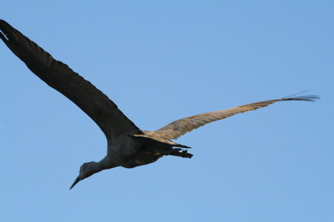 A rare close flyover. There's nothing quite like hearing the crane's sonorous purr right overhead, along with the rush of its huge slaty pinions. If you've never heard that call, please go to Susan's blog, where she has a wonderful video, with sound, of a huge crane flyover.
A rare close flyover. There's nothing quite like hearing the crane's sonorous purr right overhead, along with the rush of its huge slaty pinions. If you've never heard that call, please go to Susan's blog, where she has a wonderful video, with sound, of a huge crane flyover.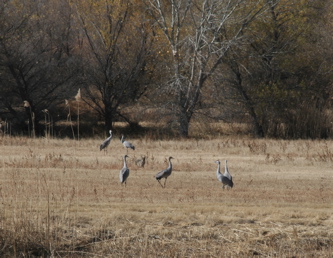 See the coyote, third from the left?
See the coyote, third from the left?The kids and I were watching a bunch of cranes out in a field when I noticed that their necks were unnaturally straight, and they had ceased feeding. "I'll bet there's a coyote around, kids!" And sure enough, a few pans of the scope revealed a pair of pointed ears in a patch of brush.
The coyotes were eating a carcass out in the field, and they really didn't pose much threat to the cranes, as long as the birds were aware of them. It's hard to sneak past a sandhill crane.
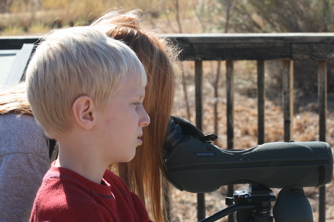
The kids were enthralled to watch a predator/prey interaction. Liam especially glued himself to the scope and fretted while Phoebe took a turn. "She's hogging it! She's had it for a hundred thousand million minutes!" We had the best time out on the refuge together. Once they settled into the slow but punctuated pace of nature watching, they were happy to while away the hours, peeking through the scope, playing with rocks and sticks and water while I looked for the next cool bird or animal to watch.
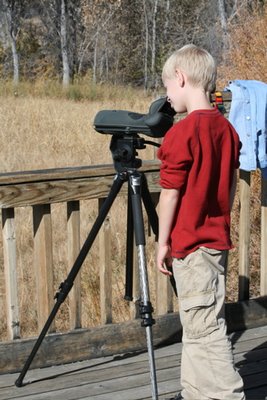 The cranes walk along the roads atop the dikes at Bosque, and they often seem to stand vehicles down, in no hurry to clear the way. It's so good to see them rule the place, when they're hunted for sport all along their flyway. Yes. Sandhill cranes are shot for sport (and occasionally for food) in every state they migrate through. There are seasons and bag limits on sandhill cranes all along their migratory route. If you don't believe me, just Google "Sandhill crane hunt." If you're sensitive, don't. Most birders, who will travel hundreds of miles to watch their migration gatherings, don't know that these "ancient birds" that they admire so much are targets for hunters, and are as shocked as I was to learn it. I think they need to know it, and I often bring it up when I'm among crane fans, even though it doesn't do much for my popularity. Talking about crane hunting in such circles has roughly the same effect as cutting a giant fart at a cocktail party.
The cranes walk along the roads atop the dikes at Bosque, and they often seem to stand vehicles down, in no hurry to clear the way. It's so good to see them rule the place, when they're hunted for sport all along their flyway. Yes. Sandhill cranes are shot for sport (and occasionally for food) in every state they migrate through. There are seasons and bag limits on sandhill cranes all along their migratory route. If you don't believe me, just Google "Sandhill crane hunt." If you're sensitive, don't. Most birders, who will travel hundreds of miles to watch their migration gatherings, don't know that these "ancient birds" that they admire so much are targets for hunters, and are as shocked as I was to learn it. I think they need to know it, and I often bring it up when I'm among crane fans, even though it doesn't do much for my popularity. Talking about crane hunting in such circles has roughly the same effect as cutting a giant fart at a cocktail party.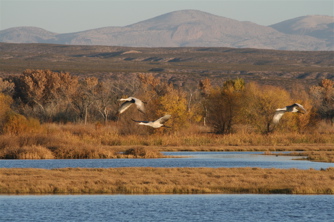 I've got an article mostly written about it, but I'm pretty sure the usual outlets for my stuff won't be interested. Maybe it's one for the next book. The thought of bringing these long-lived, monogamous, family-oriented and highly intelligent birds down for sport or roasting makes me physically ill. But then a lot of what's done in the name of sport hunting makes me ill. I know I'm getting crankier as I get older, and more conservative about speaking out because it might just be crankiness at work. But there's something about sport hunting of sandhill cranes that strikes me as fundamentally, indefensibly, sickeningly wrong.
I've got an article mostly written about it, but I'm pretty sure the usual outlets for my stuff won't be interested. Maybe it's one for the next book. The thought of bringing these long-lived, monogamous, family-oriented and highly intelligent birds down for sport or roasting makes me physically ill. But then a lot of what's done in the name of sport hunting makes me ill. I know I'm getting crankier as I get older, and more conservative about speaking out because it might just be crankiness at work. But there's something about sport hunting of sandhill cranes that strikes me as fundamentally, indefensibly, sickeningly wrong.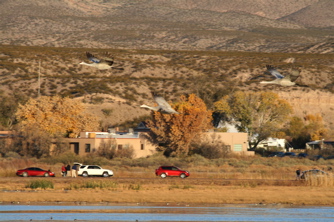 It's clear to me, if not to most state game and fish departments, that a sandhill crane is worth infinitely more alive than dead. (The same could be said of vanishing prairie chickens and sage grouse, both greatly admired by birders, hard as heck to find, and inexplicably, still hunted.)
It's clear to me, if not to most state game and fish departments, that a sandhill crane is worth infinitely more alive than dead. (The same could be said of vanishing prairie chickens and sage grouse, both greatly admired by birders, hard as heck to find, and inexplicably, still hunted.)Just go to the Platte River in Nebraska in March if you don't think so. Crowd into a blind with dozens of other paying customers, and hear their awe and stunned gasps at the beauty of the flocks sleeping and rising off the river at dawn. Here, a trio flies past the visitor center at Bosque, past people who are paying just to admire them, and let them go on their way.
It does explain why sandhill cranes almost never allow a person within gunshot range; why they are the wariest of birds. Imagine how wonderful crane watching could be if they could relax around us, the way we relax around them.
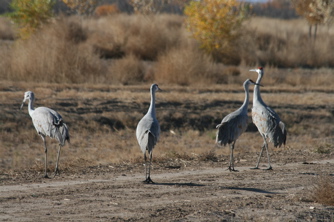
Can we find it in our hearts to just let them be?
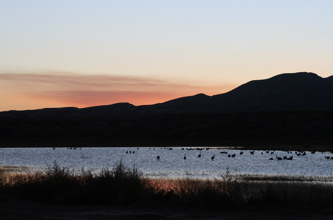
Labels: "sport" hunting, crane hunting, ecotourism, Sandhill cranes





